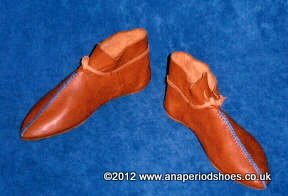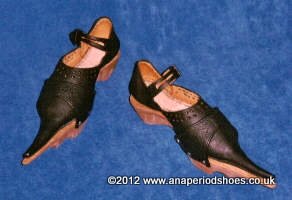Historic Craft Demonstration | Courses | Shoe Repairs | Authenticity | About ANA | Contact | Events | Links |
||
ABOUT ANA
People often ask me: "Where did you train?"
And I answer: "I am mostly self-taught..."
Peoples faces fall and they think: "Ah, an amateur."
And then I finish my sentence: "...because the last medieval shoe-maker died 500 years ago."
Ooops, I became a medieval shoemaker by accident - or was that karma?
There is nowhere to train. There is no handy college course to enrol in and then just follow the instructions.
My work is a unique combination of archaeological research and experimental reconstruction, historical studies, acting, craft and business skills.
Yes, I am mostly self-taught, but through a lucky combination of coincidences nothing could have prepared me better for my work.
I have been making historical shoes for over 10 years now. And I am still around. People have voted for me with their feet. And this is to me is a much stronger affirmation of my skills than any diploma could possibly be.
It must have been over twenty years ago, when I made my first pair of shoes. They were a colourful modern re-interpretation of the Mosegard sandals, and my friends in rural Germany were just shaking their heads. So just off and on, when a pair wore out, I would make myself another pair.
Then I moved to Britain in 1998 and expanded my vocabulary with a word that changed my life: Reenactment
I continued making shoes as a hobby just to complement my re-enactment costumes. But somehow I just cannot do things by halves and having a Ph.D. in Molecular Genetics means that I pay scientific attention to detail in whatever subject grabs my attention. In this case shoes.
Inevitably within weeks of joining a re-enactment society I found myself in museum vaults handling 1000 year old Viking shoes in York and digging through archaeological publications from all over Europe and Britain. Speaking German, French and Latin as well as English does help. The fact that my mother is a dressmaker and had started teaching me how to make my own clothes when I was only 12 years old does help too. So did the pattern-cutting course at college, which came later, just for fun, just as a hobby.
A hobby gets a little out of control
So some time around the year 2000 I found myself in Britain, in a bedsit in Bristol, with very little money and a worthless Ph.D. that qualified me to produce genetically modified cheese. Yes, I wondered at that stage too: How will genetically modified cheese save the world? And I just could not come up with a plausible answer. However I also had an obsession with historic shoes, a highly trained analytic mind, a talent for pattern-cutting and sewing any material you want, including leather and...more and more people asking me to make shoes for them!
At last a teacher, and I am getting very professional at shoemaking
Then I struck it really lucky about 11 years ago when I bumped into Sarah Juniper, historical shoemaker extraordinaire, who loves making historical shoes in principle but hates making medieval turn-shoes in particular. She took me into her workshop and taught me how to use lasts and how to make shoes properly to measure. Between the two of us we can cover any period from Stone-Age to World War II, but we operate independently from each other.
Now lets put the historical people back into the historical shoes - the craft demonstrations take off
Lets be honest, just one stitch after the next may put bread on the table but it does get knuckle-draggingly boring after a while.
I had by now made replicas for Leeds Royal Armouries, the Victoria and Albert Museum, the Ashmolean and countless other museums, theatres and film casts, but still I somehow continued to see myself as a gifted amateur.
Something was still missing. The shoes made no sense without their socio-economic context - the historical narrative.
What is often more interesting than the shoes themselves is the enigma of the peoples lives who wore them. It was quite fascinating in the beginning to rediscover historical working techniques, but it turned out to be even more exciting to study history and learn more about the people and the periods the shoes came from.
I immensely enjoyed the part of my work when I was just being a hobby-reenactor, talking to an audience about shoes and a shoemakers life, and the historic shoemakers' customers' lives. This led to my development of the historical craft demonstrations that I mostly give these days, where I do still talk about medieval shoe-making techniques, but where my main aim is to transport the audience back into the world in which these shoes were originally made.
Then in 2003 English Heritage came knocking and booked me as a historical craft demonstrator for 8 days at their medieval village in Kenilworth.
You could have knocked me down with a feather. My knees were shaking, but I was ready for the job and have never looked back.
Since then I have had the privilege to work as a medieval shoe-maker in countless historical locations all over Britain.
And I still have not seen them all, and still there are questions coming from the audience that nobody asked me before. And amazingly enough, more often than not I do know the answer.
And then I wake up in morning and I open the curtains, and it is raining again and I will be making yet more shoes and all is well.
To find out more about my availability as a historical craft demonstrator or for bookings see Craft Demonstration.
To have a look at the shoes you can buy from me see Shoes Made to Order.
I Home I
© Ana Deissler 11-2012


